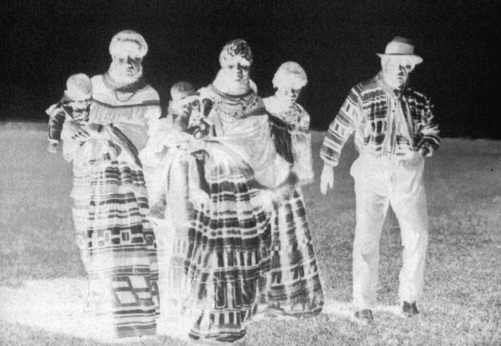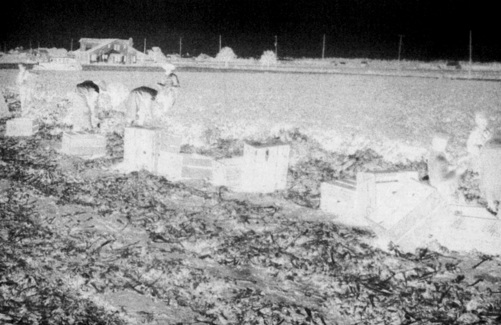The History of Florida (67 page)
Read The History of Florida Online
Authors: Michael Gannon
Tags: #History, #United States, #State & Local, #Americas

istration concentrated on long-range reform. One many-faceted program
was the Works Progress Administration (WPA), which aimed to provide
work for the employable in positions they were able to handle. Between
1935 and 1941, the WPA completed almost 1.5 mil ion projects, although
critics claimed that the initials meant “We Poke Along.” Many WPA proj-
ects benefitted Florida, including the work of its subdivisions such as the
National Youth Administration (NYA), Federal Theatre Project, Federal
Writers’ Project, and Federal Art Project. By 1935 the WPA was primar-
ily responsible for most of the able-bodied workers on Florida’s relief rol s.
Opposition to the National Social Security Act of 1935 yielded eventual y
to acceptance, and Social Security became a permanent part of American
life. Also in 1935, the National Labor Relations Act (NLRA) reflected the
New Deal’s sympathy toward organized labor, and its provisions spurred the
growth of the AFL (American Federation of Labor) and especial y the CIO
(Congress of Industrial Organizations).
In the late 1930s, leftist radicals attacked the New Deal for not going far
enough, while extreme conservatives believed that it had gone too far. Af-
ter 1938, conservative southern politicians often al ied with Republicans
320 · William W. Rogers
to defeat or emasculate New Deal measures, and popular support also
declined. Roosevelt had cause to be grateful to Florida’s Senator Pepper,
whose campaign included support of a stal ed wages and hours bil . Pepper’s
reelection assured congressional passage. Roosevelt’s attempted “purge” of
conservative Democratic senators and representatives in 1938 failed. As
New Deal support waned, gathering threats to world peace by Germany,
Italy, and Japan resulted in war in Asia and Europe. Roosevelt, by shifting
his emphasis to a program of domestic preparedness and support for the Al-
lied powers, held the Democratic coalition of liberals, southerners, blacks,
ethnic groups, and organized labor together and won a third term.
The experiences of Apalachicola and Franklin County were a microcosm
of the New Deal. People there were reassured on seeing evidence of FDIC
membership posted in the local bank’s window and the Blue Eagle posters
in various stores. The WPA took over local public works projects and em-
ployed hundreds of people. FERA funds financed a Carrabelle mattress fac-
tory and an airport at Apalachicola. Other WPA and PWA allocations fur-
ther stimulated the economy. A new courthouse was built and opened with
federal monies. In 1937, forty-six county men were enrolled in the CCC. By
1938, the county had 125 citizens working on federal projects and another
281 engaged in part-time work. The most visible achievement was the open-
proof
ing of the John Gorrie Bridge. Contact with east Florida had been restricted
for more than 100 years by Apalachicola Bay; the townspeople now had a
convenient modern bridge and causeway, which stood as a symbol of hope.
State and local politics and programs also had their influence. The state’s
most valuable possession was its people. The state grew more slowly than
during the 1920s, but it did not stagnate. Total population increased between
1930 and 1940 by 409,203. There were 1,897,414 Floridians in 1940; blacks
numbered 433,714 and whites 1,037,198. Black and white women slightly
outnumbered their male counterparts.
Few jobs in urban centers, reduced living expenses, and greater availabil-
ity of food caused many people to remain in rural areas. Between 1930 and
1940, Florida’s urban white population increased only slightly, from 72.3 to
72.5 percent. Its black urban population actual y declined from 27.7 to 27.4
percent. The number of farms grew by 3,500, and the average acreage rose
from 85.2 to 133.0. With 173,065 residents, Jacksonville was only marginal y
larger than Miami, which had 171,172. Tampa was the state’s third-most-
populous city, with more than 100,000 residents. Florida was urban, but St.
Petersburg was the only other city with more than 50,000. Otherwise, only
Orlando and West Palm Beach had more than 30,000 people.
The Great Depression · 321
Changes during the Depression also affected the state’s Native Ameri-
cans. In 1930 Florida had approximately 500 Indians. Known col ectively
as Seminoles, they were dispersed through much of south Florida. Pov-
erty, lack of organization, and the presence of at least two distinct groups
threatened their tribal integrity. In 1934, the federal government offered a
program that encouraged tribal government, land purchases to permit con-
centration of population, and education. This Indian New Deal fostered a
sense of viability. Aid was channeled through CCC–Indian Division work
programs to help fight persistent social problems.
Since its people were Florida’s greatest asset, their overal health was
fundamental y important. In the 1930s significant progress was made in
this area. The Florida constitution of 1885 had mandated a State Board of
Public Health, but the agency remained underfunded and neglected until
1931, when the legislature provided for county health departments. Coun-
ties were allowed to levy special taxes to support them, and Taylor County
was the first to establish a health unit. Ultimately the activities of these units
included communicable disease control, hygienic programs, protection of
food and milk, and extensive laboratory work. After the Social Security Act
of 1935, more health funds became available. By 1940 the state board oper-
ated a mobile X-ray unit and had many clinics (segregated by race). Because
proof
Florida led the nation in deaths from syphilis, sixty-seven clinics were set
up, and they proved effective. Important work was accomplished in com-
batting hookworm, malaria, and pneumonia. In 1939, state officials drafted
a school health plan and coordinated it with community health programs.
WPA funds also were expended for sanitation and various medical projects.
For Floridians to achieve their potential, the state had to have an efficient
public school system. The Depression dealt a crippling blow to that am-
bition. Funding for public education dropped, and in 1931 Florida ranked
forty-third in average teacher pay and thirty-ninth in money spent annual y
per student. A wrenching austerity program eliminated small high schools,
enlarged elementary classes, retained old textbooks, pooled library books
countrywide, and reduced purchases of equipment. Tal ahassee and Leon
County were among Florida’s more stable areas, yet in 1933 many schools,
most of them black, were closed, and the academic year was reduced to six
months. In 1934 Florida had 446 school buses with factory-made bodies
and 752 with homemade ones. Salary reductions meant that by 1934 the
state owed teachers $312,408 in back pay. The average salary in 1936 was
$1,039 for a white and $495 for a black teacher. In the mid-1930s the state de-
partment of education estimated that only 10 to 15 percent of schoolchildren

322 · William W. Rogers
Seminole family members gather outside Miami in 1929.
would attend col ege. Based on that projection, the department opposed
proof
making the achievement of college entrance requirements a goal of a high
school education.
With returning prosperity in the late 1930s, the public school system
improved. The educational budget was increased under Governor Cone,
although teachers’ salaries remained low and tied to race, with blacks always
at a disadvantage. On the plus side, the average length of school terms in
grades one through twelve achieved near equality: for blacks 165 and for
whites 175 days. State laws required compulsory school attendance. By the
end of the 1930s, while much remained to be done, progress had been made,
especial y by blacks. Of the 663,547 young white people of school age, 54.7
percent attended in 1940. There were 195,274 blacks eligible to attend school,
and 49.2 percent of them did so.
Federal funds greatly helped Florida education. More than 500 schools,
in addition to playgrounds and athletic fields, were built or refurbished by
the WPA. Its funds were also used to provide school lunches. The state’s
colleges received WPA appropriations for capital improvements programs,
and the WPA’s education division employed more than 1,600 teachers. Vo-
cational courses were encouraged, including home economics, agriculture,
trade and industrial education, distributive education, and rehabilitation.
The Great Depression · 323
Beginning in 1935, the National Youth Administration (NYA) administered
a work-relief and employment program for school-age persons and pro-
vided part-time employment for needy secondary, col ege, and graduate
students.
The state’s school program, including higher education, remained seg-
regated by race. Florida Agricultural and Mechanical College for Negroes
at Tal ahassee continued as one of two land grant institutions. It offered a
variety of courses other than engineering and agriculture. A much larger
choice of fields was possible at Gainesvil e’s al -white, al -male University
of Florida. It boasted a Col ege of Law and a broad liberal arts program,
while no state law school was available for blacks. The Florida State College
for Women at Tal ahassee had programs in teacher education but built its
strongest reputation in the liberal arts.
Private colleges and universities, such as the University of Miami, begun
in 1926, struggled to survive. Despite the times, the University of Tampa
opened as Tampa Junior Col ege in 1931 and in 1933 became a four-year
institution. Palm Beach Junior College was established in 1933, and the next
year Jacksonville Junior College began classes (it became Jacksonville Uni-
versity in 1956). St. Petersburg Junior Col ege, Stetson University, Florida
Southern College, and Rollins College all weathered the storm. Black pri-
proof
vate institutions such as Edward Waters Col ege and Bethune-Cookman
College continued to serve their students.
Because of Florida’s climate, geographical location, and soil, agriculture
was of paramount importance. In 1940 Florida had 4,500 more white farm
owners or operators than in 1930; black owners and operators decreased
by 2,700. Only slight increases in farm mechanization were registered. The
greatest change came in the number of farm dwellings lighted by electric-
ity. Federal programs helped reduce regional utility rates of private corpo-
rations, and Floridians benefitted directly from the Rural Electrification
Administration, which, after its creation in 1935, generated and distributed
electricity in isolated rural areas. The 11 percent of Florida farm homes
lighted by electricity in 1930 increased to 26.5 percent in 1940.
From the decade’s beginning to its end, the state’s production of beef
cattle and chickens increased. Income from milk ($15,859,946) grew five-
fold. Florida established itself as a permanent major producer of winter
vegetables. Plant pathologist Herman Hamilton Wedgworth developed vi-
able fertilizers for the rich muck soil of the Everglades and grew disease-
resistant vegetables, and by 1934 his Belle Glade plant was shipping vegeta-
bles in refrigerated railroad cars to northern markets. The Duda family and
